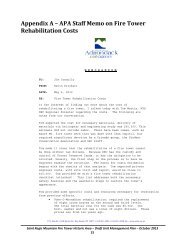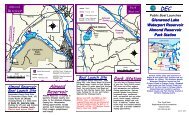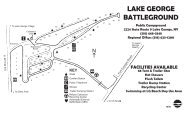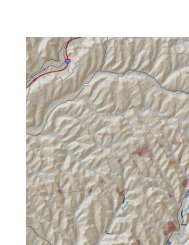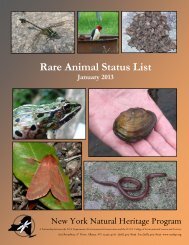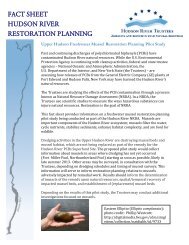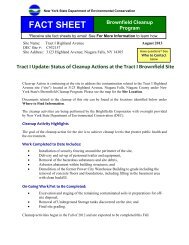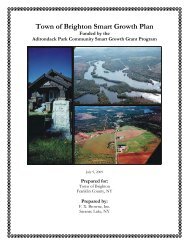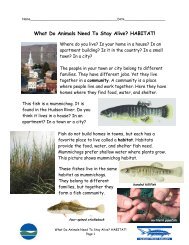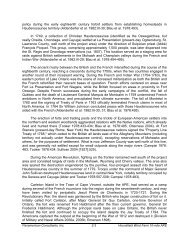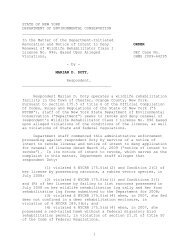2012-2013 Hunting & Trapping Regulations Guide - New York State ...
2012-2013 Hunting & Trapping Regulations Guide - New York State ...
2012-2013 Hunting & Trapping Regulations Guide - New York State ...
You also want an ePaper? Increase the reach of your titles
YUMPU automatically turns print PDFs into web optimized ePapers that Google loves.
Feral swine<br />
Bad <strong>New</strong>s for <strong>New</strong> <strong>York</strong><br />
Many people are aware of the feral swine problem<br />
in southern states like Texas and Florida,<br />
but these animals are also a growing problem<br />
in <strong>New</strong> <strong>York</strong>. Also called feral pigs, feral hogs,<br />
wild boar, wild hogs, razorbacks, Eurasian boar<br />
and Russian boar, feral swine are not native to<br />
<strong>New</strong> <strong>York</strong> and are a harmful and destructive<br />
invasive species.<br />
Feral swine can include domestic pigs or "pet"<br />
pigs that have been released or escaped captivity<br />
and "gone wild," wild boar (native to Eurasia)<br />
that escaped from fenced shooting enclosures,<br />
or a hybrid of domestic pigs and wild boar. Their<br />
color and size can be quite variable. They can<br />
be black, brown, gray, red, tan or cream colored.<br />
They can be belted (a band of color across the<br />
shoulders) or have color patterns like spots or<br />
stripes. Piglets often have stripes that fade or<br />
disappear as they get older.<br />
Feral swine are omnivorous and will eat<br />
just about anything. Feral swine are also very<br />
adaptable and can live just about anywhere as<br />
long as they have access to water. They breed<br />
early and often. If weather is good and food<br />
is plentiful, feral swine can breed as early as<br />
6-10 months of age, can breed twice a year and<br />
their litter size averages 6-8, although litters<br />
as large as 10-12 have been reported. As a<br />
result, a feral swine population could easily<br />
double in a year.<br />
<strong>New</strong> <strong>York</strong> is currently reviewing strategies<br />
for preventing the establishment and spread<br />
of feral swine on the landscape. If you see any<br />
feral swine in NY, please report them to the<br />
nearest DEC regional wildlife office or e-mail<br />
us at fwwildlf@gw.dec.state.ny.us . Please<br />
report the number of swine seen, whether any<br />
of them were piglets, the date, and the exact<br />
location (county, town, distance and direction<br />
from an intersection, nearest landmark).<br />
Although some people may think of these as<br />
“trophy” animals to hunt, the consequences of<br />
feral swine in <strong>New</strong> <strong>York</strong> would be devastating<br />
to deer and turkey, other native wildlife and<br />
the environment. Please help prevent this<br />
from happening!<br />
Feral swine have tremendous<br />
negative impacts on native wildlife<br />
as well as native plants, livestock,<br />
agriculture and humans:<br />
Feral swine:<br />
•Can locally decimate the fall<br />
acorn crop, leaving virtually none<br />
for native wildlife such as bear,<br />
turkey, white-tailed deer, squirrel<br />
and waterfowl.<br />
•Disturb and prey on groundnesting<br />
birds (like turkey and<br />
grouse) and their eggs which may<br />
decrease game bird populations.<br />
•will kill and eat fawns and<br />
young domestic livestock.<br />
•Prey on reptiles and<br />
amphibians (such as snakes,<br />
lizards, frogs and salamanders) and<br />
their eggs which may impact these<br />
populations.<br />
•will eat almost any<br />
agricultural crop as well as tree<br />
seeds and seedlings.<br />
•Tear up lawns and golf<br />
courses to eat the tender roots,<br />
grubs and worms.<br />
•wallow in wet areas where they<br />
destroy native vegetation, cause<br />
erosion, and negatively affect water<br />
quality.<br />
•Have razor sharp tusks and can<br />
be aggressive toward humans, pets<br />
and livestock.<br />
•Can carry and transmit at<br />
least 30 diseases including<br />
swine brucellosis, E. coli,<br />
trichinosis, and pseudorabies<br />
to native wildlife, livestock, pets<br />
and humans. Pseudorabies, if<br />
transmitted to domestic swine, can<br />
decimate NY’s pork industry.<br />
<strong>2012</strong>–13 HuNtING & traPPING GuIDe 23



